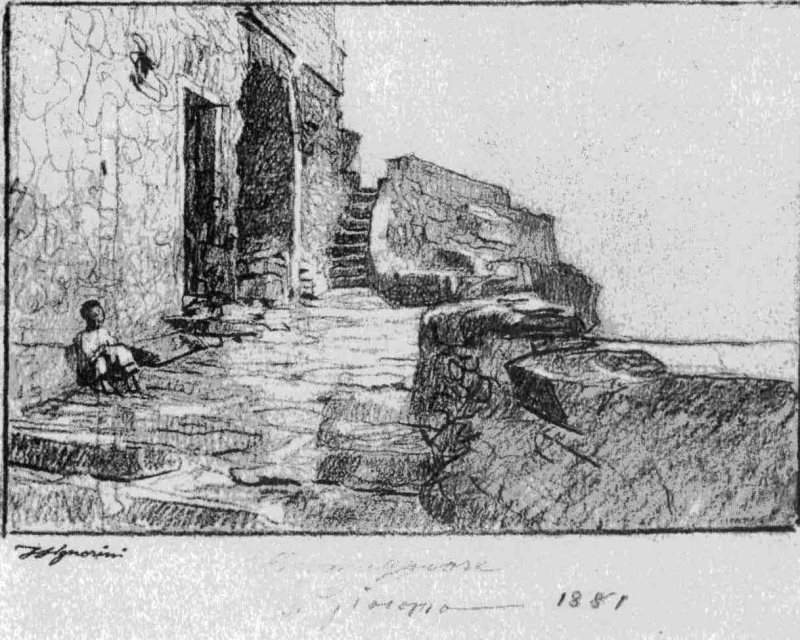What was Riomaggiore like in the 19th century? Here in a book are the drawings of Telemaco Signorini
The Töpffer Edizioni publishing house has published an important volume on Telemaco Signorini ’s (Florence, 1835 - 1901) stays in Riomaggiore: the book, entitled Telemaco Signorini. Riomaggiore: The Diaries, the Drawings, with a preface by Marzia Ratti (director, from 1990 to 2019, of the Civic Museums of La Spezia), contains excerpts from Signorini’s diaries relating to his relationship with Riomaggiore as well as the drawings that the artist made in the first village of the Cinque Terre, then an almost wild land, as the author himself had the opportunity to write about it on the occasion of his first trip, in 1860, when he was twenty-five years old (at that time Riomaggiore could only be reached on foot and the inhabitants had very little contact with the outside world: Signorini could essay their distrust as soon as he arrived).
But it is not only in the written memory that the great Macchiaioli painter’s connection with the Ligurian village is established: Signorini, in fact, produced a large number of drawings in Riomaggiore, which constitute almost a chronicle of the village, with an impressive size. The drawings, in fact, include not only landscapes, but also portraits of the people of the village: for many of them the painter also transcribed names and nicknames, evidence that his sheets were not only related to his artistic activity, but were also a way of fixing in memory a face or a person. And so here is a succession of names among the artist’s sheets, such as “Clelia di Nanni,” “Martorò,” “Pellegro dei Menin,” “Davidin di Giacon,” “Concettina di Patatin,” “la fantela” (i.e., the little girl) of “Bacciarin,” and so on. The book also contains reproductions of two rediscovered drawings by the Florentine artist: these are the portraits of Adamo and Girumina dei Purin, two children, the children of the village shoemaker, published in 1969, and donated in 1974 by the heirs of the two children depicted by Signorini to the Riomaggiore Municipality. The two sheets had been lost in the municipality’s archives and were fortuitously found last year.
 |
| The cover of the book Telemaco Signorini. Riomaggiore: the Diaries, the Drawings |
“Perhaps no town like Riomaggiore,” writes Marzia Ratti in the book’s preface, “has had such a documented visual chronicle as much in the characteristics of the people as of the places. And just because of the lack of knowledge of the details depicted until not so many years ago, so many paintings were misidentified with other places. Today, thanks to the dissemination of images through the web and social networks, one can have fun correcting the false identifications and bringing back to the centrality of the place depicted, Riomaggiore and the Cinque Terre, many of Signorini’s works scattered around the world, fancifully titled. Just as it will be possible to trace the identification of the men and women by the present inhabitants of Riomaggiore who are his direct descendants.”
Telemaco Signorini, born in Florence on August 18, 1935, the son of another important painter, Giovanni Signorini (the relationship between the two was investigated in an important exhibition held last year in Florence, at Palazzo Antinori), and Giustina Santoni, enrolled at the Accademia di Belle Arti in Florence in 1852 and shortly after, together with his colleagues Vincenzo Cabianca and Odoardo Borrani, and in the wake of what the Apulian Francesco Saverio Altamura, who in 1855 returned to Florence from Paris after learning what was being painted beyond the Alps, was accomplishing at the time, he began to experiment with what would later become macchia painting. The first trip to Riomaggiore, as recalled, was in 1860, after his experience as a Garibaldian volunteer: in the company of Cabianca, he visited La Spezia and its environs, particularly the villages of Arcola, Pitelli, Lerici, San Terenzo, Vezzano Ligure and Sarzana, and then found in Riomaggiore the ideal place, in an area of Liguria that, unlike the villages of the Gulf of Poets, was then almost unknown and waiting to find its own artistic dimension.
The book Telemaco Signorini. Riomaggiore: the Diaries, the Drawings, a doubly useful tool (to learn more about Signorini’s art and his person, and to see what one of the villages now among the most visited in the world was like at the end of the 19th century), is on sale now for 24.50 euros. The book can be purchased directly from the publisher’s website, in all online bookstores and in the best physical bookstores.
 |
 |
| What was Riomaggiore like in the 19th century? Here in a book are the drawings of Telemaco Signorini |
Warning: the translation into English of the original Italian article was created using automatic tools. We undertake to review all articles, but we do not guarantee the total absence of inaccuracies in the translation due to the program. You can find the original by clicking on the ITA button. If you find any mistake,please contact us.



























